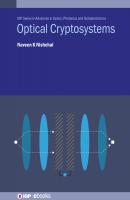Optical Cryptosystems. Naveen K. Nishchal
Чтение книги онлайн.

Читать онлайн книгу Optical Cryptosystems - Naveen K. Nishchal страница 11
Название: Optical Cryptosystems
Автор: Naveen K. Nishchal
Издательство: Ingram
Жанр: Отраслевые издания
isbn: 9780750322201
isbn:
Property 2 helps establish the fact that although input plane RPM is not required for the retrieval of original information, the use of both the RPMs is important in converting the image to be encrypted into a white stationary noise. The use of input plane RPM makes the input image white but nonstationary and not encoded. Fourier plane RPM maintains whiteness and stationarizes and encodes the input image [1–3].
The publication of the pioneering ‘double random phase encoding’ attracted the attention of the research community and since then a large number of research papers have appeared in literature. This scheme has been implemented in different transform domains including fractional Fourier transform (FRT), Fresnel transform (FrT), gyrator transform (GT), wavelet transform (WT), and fractional Mellin transform. Also, other techniques such as asymmetric cryptosystems, phase-only encryption, multiple image encryption and color image encryption, have been reported. The brief introduction of some of the optical image encryption techniques in various transforms has been discussed in the following subsections.
2.2.2 Encryption using fractional Fourier transform
The fractional Fourier transform (FRT) is a generalization of the ordinary Fourier transform with an order parameter α. A Fourier transform is a first order FRT with α = 1. The FRT operator follows the mathematical properties such as linearity, continuity, self-imaging, partial convolution/correlation. The properties and applications of the ordinary Fourier transform are special cases of those of the FRT [12–16]. In every area where Fourier transform and frequency domain concepts are used, the potential exists for generalizations and improvement by using the fractional transform. Efficient algorithms exist in literature to compute FRTs in about the same time as discrete Fourier transform [13–15]. Optical implementations based on bulk systems can be performed using either a single lens system or with a two lens system [12]. Therefore, the generalization of Fourier transform to the FRT comes at no additional cost whether computed digitally or implemented optically. If FRT of order α is denoted by ℑα, then its inverse is denoted as ℑ−α. It has found many applications in optical and digital signal and image processing where the ordinary Fourier transform has traditionally played an important role. The FRT of a function f(x1,y1) is defined as [16]
g(x2,y2)=∬f(x1,y1)Bp(x2,y2;x1,y1)dx1dy1(2.20)
where Bp(·) is the kernel of the 2D FRT given by:
Bp(x2,y2;x1,y1)=Kexpiπx22+x12+y22+y12tanα−2iπx1x2y1y2sinα(2.21)
Here, α=pπ/2 where p denotes order of the FRT and
K=exp−j14πsgn(sinα)−α2∣sinα∣1/2(2.22)
where K represents a complex constant and sgn refers to the signum function. For optical implementation of FRT, two geometries have been proposed; through a two lens system and a single lens system [12]. Figure 2.3 shows the schematic for obtaining FRT through a single lens system. In this case, the input function could be placed at any location within the focal length of the lens (d < f). The distance to input and output planes from the lens are the same but less than the focal length. The symbol ‘f’ denotes the focal length of the lens. The optical implementation of FRT with a single lens corresponds to free-space propagation (shearing of Wigner distribution function in the x-direction), passage through a lens (shearing in the y-direction), and again free-space propagation (shearing in the x-direction). The distance parameter, d = f1 × tan(α/2), f1 = f × tan(α/2), where f is the focal length of the lens.
Figure 2.3. Schematic diagram for optical implementation of FRT with a single lens system.
The ciphertext generated by using DRPE in the FRT domain is written as [17–20]
E(x,y)=ℑβℑαf(x,y)×exp(i2πR1(x,y))×exp(i2πR2(u,v))(2.23)
Here, values of α and β are important for the retrieval of original information in addition to the use of respective RPMs. For decryption, the usual reverse process of encryption, as explained in section 2.2.1, is to be followed. Because the order of the FRT can take any value between 0 and 1 therefore, if the DRPE is implemented in the FRT domain the information of orders enlarges the key space and the cryptosystem becomes stronger. For this reason, fractional Fourier domain encoding attracted the attention of the researchers community.
Extending the concept of FRT, extended FRT has been reported [21]. The benefit of the transform is that the distance to input and output planes from the lens can be different, less than or greater than the focal length of the lens. Hence, the distances become asymmetric and offer additional degrees of freedom while applying it for encryption applications.
Figure 2.4 shows the schematic for obtaining extended FRT through a single lens system. In this case, the input function could be placed at any location, which can be less than or greater than the focal length of the lens and this fractional focal plane can be arbitrarily decided. Following 1D representation for convenience, the extended FRT of a function f(x) is defined as [21],
g(u)=K∫f(x)expiπa2x2+b2u2tanα−2iπabxusinαdx(2.24)
The function g(u) is related to f(x) by an FRT with three parameters a, α, and b. K is a complex constant. The parameters a, α, and b are called quadratic phase system (QPS) parameters and in general they are complex quantities. Performing an extended FRT on a function is equivalent to expanding the function ‘a’ times, performing an FRT of order α, and contracting the resultant distribution ‘b’ times. The QPS parameters are related to the distances d1 and d2 and the focal length f of the lens through the following expressions.
a2=1λf−d2f−d11[f2−(f−d1)(f−d2)]1/2(2.25)
α=arccosf−d1f−d2f(2.26)
b2=1λf−d1f−d21[f2−(f−d1)(f−d2)]1/2(2.27)
If the distance parameters d1 and d2 are taken as the same and less than the focal length of the lens, then the expression reduces to FRT. When the distance parameters are considered larger than the focal length of the lens then QPS parameters become complex quantities. Thus, while implementing extended FRT СКАЧАТЬ